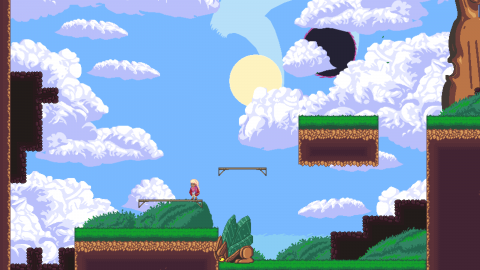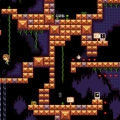Made by but two people, a casual game developer named Jelle van Doorne and online composer Nom Tunes, Viola: The Heroine’s Melody is a sort of love letter to the input RPG formula made famous by the Mario RPG games. It’s also an example of an old school isekai anime story about girls going through a coming of age adventure, making good use of that set up for some charming character work, free of modern trends. Despite some odd bugs and technical issues, it manages to be one of the more charming and unique examples of the indie RPG scene, and meets its ambitions more often than not.
The story follows the titular Viola, a girl trying to play violin and doing badly at it. Then, suddenly, her violin floats into the air and she’s sucked into a portal, finding herself in a magical world and assisted by a powerful and friendly dogman, who decides to help her find her way back home. She soon meets a variety of people who join her on her quest, with further intrigue caused by her appearance also summoning a flood of monsters, and a mysterious demon named Justice seemingly having it out for her for unknown reasons. That’s not even getting into her violin becoming a magical bow in fights, something not even the natives of this world can explain. Just what is happening, and why has Viola ended up in the middle of it all?
There’s a unique energy to this game, and the writing plays a big part of that. It’s a very funny game that uses humor to defuse more emotionally charged moments as needed, as the story explores themes of empathy, bonds, guilt, and dealing with loss. It strikes a careful balance, helped along by every character being quite flawed yet still likable. All your party members even have personal quests you can do when you near maxing out their social bonds at campfires, which give a good few of them extra layers.
It’s a good mix of charm and emotional vulnerability, as Viola’s own emotional turmoil is compared to her party members. She struggles with her mixed race identity, but gets some help accepting her differences from a catboy mage named Niko, who struggles with a physical handicap. The mage Sybil ends up having more in common than Viola when it’s revealed how badly she’s really taken the death of a good friend. Even Fenrys, your starting dogman companion, gets a good explanation as to why he tries to be so helpful to strangers, but can be prickly with others, with a shocking reveal in his personal quest. People are allowed to mess up and learn from their mistakes, while not invalidating the damage they did and showing some of the party not ready to forgive at points.
Music, of course, acts as the main motif, from Viola using her violin as a weapon, to your party joining in to play songs. There are nine songs in the game that can create various effects (think Ocarina of Time), and you have to first practice a piece with your party before you can have the notes laid out for you from your songbook. It ties in well with Viola’s struggle to learn to play, and her frustration and seeming fear of failing at something her mother did so well. It’s even pushed as something that can bring people together, as it shows just the act of empathetic expression can help people in ways you may not first expect. Your party also all use different instruments, so who you have on your team at the time even changes how the song sounds.
All of this is further pushed in the battle system, which comes in play via the platforming sections. While there is an overworld map for selecting areas and using the cat shop (because it is run by a cat, you see), most playtime will be exploring a handful of levels. Viola can pull off wall jumps and a Super Mario 64 style triple jump to increase jump height, with the rather spacious levels giving plenty of room to let you maneuver. Even Donkey Kong Country barrels are present as cannons for little platforming shake ups. Your skills probably won’t be tested, but as a way to have exploration in an RPG a bit different than usual, it succeeds quite well and properly divides up the adventure in satisfying chunks.
If you touch a monster in these segments, you end up being brought to a turn based battle with up to four of your companions. You have options to guard (which allows the user to take a weakened hit for another party member), attack, use items, magic and skills, or even flee, as standard. Attack requires you to do a brief minigames where you press a shown button at the right time, always randomized. Magic and crescendos (which build points to use them as you take damage) always have the same inputs, but are usually more complex. These can also work in hold and mash prompts, and more than a few require a few goes to get down. It fits into how the songs work, requiring a bit of practice before you nail it and can “play” them as you need in fights.
The game nails the execution of its mechanics well enough to last for the full ten hour or so adventure, not too complex, but offering enough options to make it a bit varied. This includes the equipment system, which is limited to gems. Every character can equip two gems, usually with both stat buffs and debuffs. This means you can modify a few characters to give them more specific roles in the party, though it isn’t necessary as long as you don’t avoid fights often. You can get absolutely stacked level wise, to the point the extra bosses in some personal quests and late game enemies are barely threats.
The one hiccup is that the game has more than a few bugs causing odd issues. Over our playthrough, there were two points Viola got caught into the floor of the level, the first time requiring a return to the title screen and restarting the level. Sybil’s third crescendo also didn’t work correctly, with a mash prompt showing the wrong button and a fireball effect playing late and then hovering over the party until the battle ended. One gem also seemed bugged, with slightly messed up text cutout, that made leaving the cat shop when in selling mode impossible. Thankfully, there’s not a lot to buy if you explore levels to find a whole heap of potions hidden in them.
The sprite art is also a bit of a mixed bag, but far more forgivable due to it being the work of one person. The backgrounds are very detailed, and the level and battle sprites expressive and cute. Some of the portrait art feels off at times, like how everyone stares straight ahead in dialog art sometimes resulting in unflattering angles, but it mostly works and keeps the cartoony vibe the game is going for. The one disappointment is that magic and crescendos tend to have lackluster effects, outside a few stand outs.
Despite some flaws that come from making something so complex with just a single developer, Viola managed to do everything it needs to in order to be a satisfying romp. It has a unique soul that manages to do more than expected with a lot of familiar archetypes, and might even get a tear from some more sensitive players. It’s a sweet little story with a strong, simple message that shouldn’t be overlooked, and is a good contender for a game to play with your kids, with life lessons well conveyed to boot.


